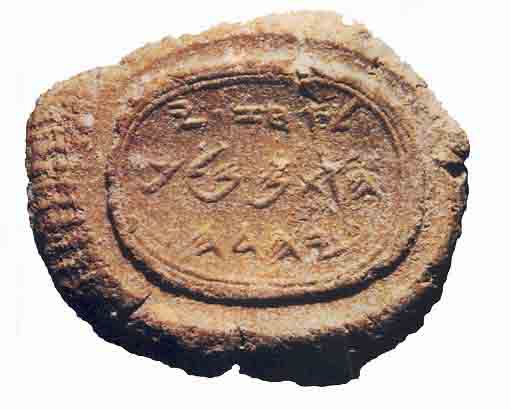Seal of the Traitor King

Archaeological evidence of specific persons and events from the ancient Near East is spotty and some of the time sketchy. For example, the Seal of King Ahaz. If memory serves, the Seal is now part of a private collection, and, as it was acquired via the antiquities market, its provenance is difficult to demonstrate conclusively. That said, the Seal is likely authentic. It bears an inscription that indicates it belonged to Ahaz, son of Jotham, and king of Judah.
Ahaz was king of Judah circa 732-716 B.C. He rejected an alliance with Pekah of Israel and Rezin of Damascus to oppose the Assyrians. Acting against the advice of Isaiah, Ahaz allied with the Assyrian king Tiglath-Pileser III. Israel and Damascus both fell to the Assyrians. Ahaz swore fealty to Tiglath-Pileser III and the Assyrian gods, and he defiled the Temple and even sacrificed one or more of his sons to Moloch. Ahaz died at about the age of 36. His son Hezekiah became king, and Ahaz was refused burial in the sepulchre of kings. Hezekiah had the priests and Levites repair and reconsecrate the Temple. According to rabbinic literature, Hezekiah was saved by Abi, his mother, who annointed him with salamander blood, thus making it impossible for Moloch’s fire to harm him.
In the seventeenth year of Pekah son of Remaliah, Ahaz son of Jotham king of Judah began to reign. Ahaz was twenty years old when he became king, and he reigned in Jerusalem sixteen years. Unlike David his father, he did not do what was right in the eyes of the Lord his God. He followed the ways of the kings of Israel and even sacrificed his son in the fire, engaging in the detestable practices of the nations the Lord had driven out before the Israelites. He offered sacrifices and burned incense at the high places, on the hilltops and under every spreading tree. (The Second Book of Kings 16:1-4)

Seal of the Traitor King
Wondrous item, very rare (requires attunement)
This stone seal possesses dread magic. When smeared with blood and pressed against a surface, it invokes certain powers, depending on the type of blood used. In all cases where applicable, targets of one of the seal’s effects must make a DC 16 saving throw. The seal has 3 charges. Each use of the seal expends 1 charge. The seal regains 1d3 expended charges daily at dawn.
Beast Blood: The seal protects wards up to 2,500 square feet of floor space with the seal in the center of the warded area. This power duplicates the effects of guards and wards.
Monstrosity Blood: The seal creates explosive runes (see glyph of warding) as if cast using a 6th-level spell slot.
Humanoid Blood: The seal protects an area as a glyph of warding, but a creature who triggers the seal is targeted by bestow curse as if cast using a 6th-level spell slot.
Whenever a non-evil creature attunes to the seal, it must make a DC 16 Charisma saving throw. On a failed save, the creature’s alignment shifts one step closer to neutral evil, moving from lawful or chaotic before moving from good or neutral. For example, a lawful good creature who fails the saving throw becomes lawful neutral. A chaotic good creature who fails the saving throw becomes neutral good. Whenever the attuned creature expends a charge from the seal, the creature must make a DC 16 Charisma saving throw or suffer the same effect.

Leave a Reply